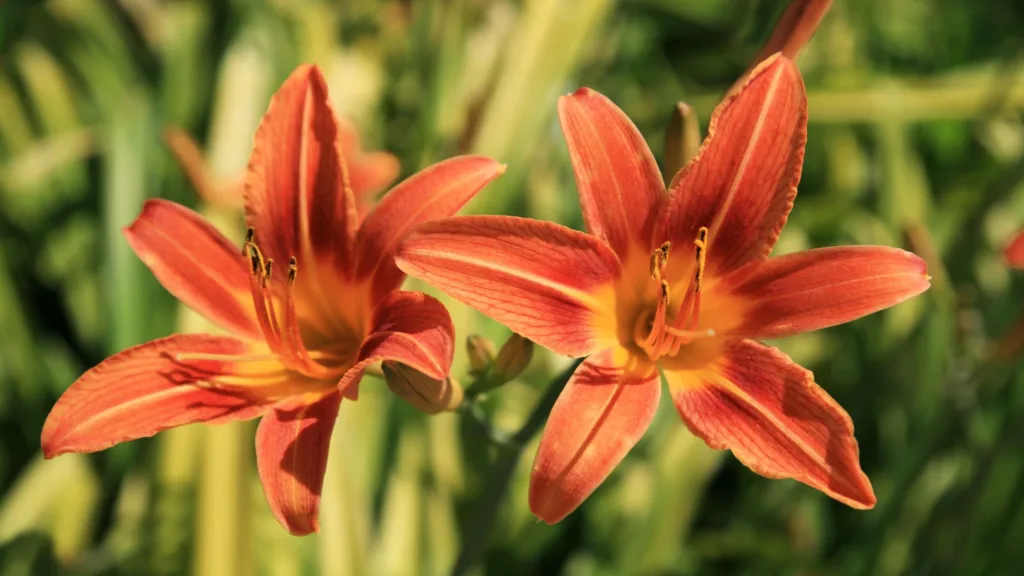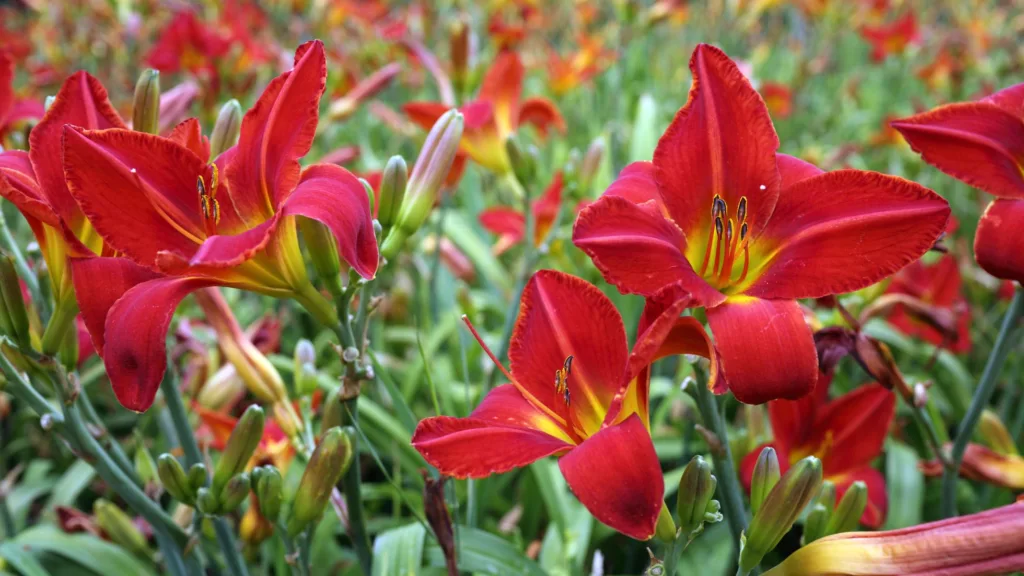Daylilies are colorful, trumpet-shaped flowers that are popular in gardens around the world. They are known for their ease of care and long bloom time. Despite their name, daylilies are not true lilies. derived from the Greek words for “day” and “beauty,” reflects the short lifespan of each daylily flower.

Planting, Growing, for Daylilies
Daylilies are a gardener’s delight, offering vibrant blooms with minimal fuss. Here’s a breakdown of planting and growing these low-maintenance perennials:
Planting:
- Timing: Aim for spring or fall when temperatures are mild. In southern regions, fall planting allows roots to be established before winter.
- Location: Daylilies thrive in full sun (at least 6 hours a day) for best flowering. In hot places, they can handle some afternoon shade. In hot places, they can handle some afternoon shade.
- Soil: Well-drained soil is key. Amend the planting area with compost or organic matter for better drainage and nutrient content.
- Planting the Daylily: Dig a hole 2-3 times wider than the root system.
- Form a mound of earth in the middle. Place the daylily on the mound, spreading the roots. Ensure the crown (where the leaves meet the roots) is level with the soil surface or slightly below (about an inch). Fill the hole with dirt, firm it gently, and water well.
- Spacing: Space daylilies 18-24 inches apart to allow for proper growth.
Growing:
- Watering: Water regularly, especially during the first year or during dry spells. Aim for wet, but not soggy, soil.
- Mulching: Apply a 2-3 inch layer of mulch around the base of the plant to retain moisture, suppress weeds, and regulate soil temperature.
- Fertilizing: Daylilies are not heavy feeders. A yearly application of compost or a balanced fertilizer in early spring is sufficient.
- Deadheading: Removing spent flowers (deadheading) encourages continuous bloom throughout the season. Simply pinch off the faded flower where it meets the stem.pen_spark
How to Care for Daylilies
Caring for Daylilies is quite simple. Here are some key tips:
- Sunlight: They like full sun but may tolerate little shade.
- Watering: Keep the soil wet, particularly throughout the growth season. Water deeply once a week.
- Soil: They prefer well-draining soil with plenty of organic matter.
- Fertilizing: Apply a balanced fertilizer in the early spring and again during the flowering period.
- Dividing: Every 3-4 years, divide the clumps to prevent overcrowding and to promote vigorous growth.
Types of Daylilies
Daylilies come in a variety of types, each with its unique charm. Here are a few:
- Stella De Oro Daylily: Miniature golden trumpet
- Common Orange Daylily: Classic orange beauty
- Yellow Daylily: Lemon-coloured delight
- Long Yellow Daylily: Tall and fragrant
- Amur Daylily: Edible orange-yellow blossom
- Dwarf Daylily: Excellent ground cover
- Rosy Scenario Daylily: Pretty pink flower
- Pardon Me Daylily: Velvety burgundy-red blossom
- Pink Damask Daylily: Showy pink star
- Stafford Daylily: Incredible burgundy stripes
- Chicago Apache Daylily: Bold red funnel
- Happy Returns Daylily: Pale yellow compact
When to plant daylily seeds
The best time to plant daylily seeds is in the spring, as soon as the ground can be worked. You can start the seeds indoors 8 to 10 weeks before the last frost in spring, or sow them directly into the garden once it is warm enough, usually around May 1. In warmer climates like India, you might be able to plant a bit earlier, but it’s important to ensure that there is no risk of frost and the soil is warm.
Daylilies garden ideas
Daylilies are versatile plants that can be used in a variety of garden designs. Here are a few suggestions to get you started:
- Mass Planting: Daylilies are stunning when planted in large masses. This creates a bold and colorful statement in your garden. You can use a single variety of daylily for a uniform look, or mix and match different colors and heights for a more vibrant display.
- Borders: Daylilies are perfect for planting along borders. Their tall stems and colorful flowers will add interest and beauty to your garden edges. Choose daylilies that complement the height and color of other plants on your border.
- Cottage Garden: Daylilies add a touch of whimsy and charm to cottage gardens. Plant them with other flowering plants such as roses, lavender, and hollyhocks.
- Pollinator Garden: Daylilies are a favorite food source for butterflies, hummingbirds, and bees. Plant them in a sunny spot with other pollinator-friendly plants to create a haven for these important creatures.
- Formal Garden: Daylilies can also be used in formal gardens. Plant them in symmetrical beds for a classic look.
Daylilies bloom time
Daylilies are known for their extended bloom time, but the exact timeframe depends on the variety and your location. Here’s a breakdown:
- General Bloom Time: Most daylilies bloom in June or July.
- Early, Midseason, and Late Bloomers: However, there are varieties that bloom earlier or later, allowing you to extend the bloom season in your garden.
- Early Bloomers: These start the show in late spring, May or June in northern regions.
- Midseason Bloomers: This is the peak bloom period, typically from May in the South to July in the North.
- Late Bloomers: These varieties keep the flowers going 4-6 weeks after the season’s peak, often lasting into late summer or even fall in some areas.
- Reblooming Daylilies: Some special daylilies are rebloomers, putting on multiple flowerings throughout the season, often in spring and then again in late fall.
Daylilies Other Languages names
- Spanish: Hemerocalis
- French: Hémérocalle
- German: Taglilie
- Italian: Giglio di un giorno
- Chinese (Mandarin): 萱草 (Xuān cǎo)
- Japanese: ヘメロカリス (Hemerokarisu)
- Telugu: రోజా పువ్వు (Roja Puvvu)
- Tamil: அல்லி பூ (Alli Poo)
- Kannada: ಹೆಮೆರೊಕಾಲಿಸ್ (Hemerokalis)
- Hindi: हेमेरोकैलिस (Hemerokalis)





